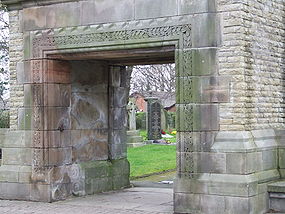- Matthew Curtis
-
Matthew Curtis (1807–1887) was an industrialist and civic leader in Manchester. He was Mayor of Manchester three times.
Born in Manchester in 1807,[1] Curtis was initially apprenticed to the firm of Joseph Chessborough Dyer,[2] subsequently becoming foreman, and then succeeding in 1836 to the ownership of Dyer's business, which became Curtis, Parr & Walton.[3] By trade, Curtis was a wire-card manufacturer and a machine-maker. He was a partner in two businesses: Curtis, Parr & Walton, wire-card makers, and Parr, Curtis & Madely, machine-makers. These firms were involved in the manufacture of equipment for spinning cotton, the former in the production of Dyer's Frame and the latter producing Smith & Orr's Self-Acting Mule. By the middle of the nineteenth century, Curtis's firms were the largest manufacturers of cotton-spinning machinery in Britain.[4]
In December 1875, during his second term as Mayor of Manchester, Curtis put in place the copper ball on the summit of the Albert Square tower of the new Manchester Town Hall, which was nearing its completion in 1877.[5] Curtis was a council member of the Manchester Anti-Corn Law Association[6] and a founding director of the Manchester Athenaeum.[7] He resided at Thornfield in Heaton Mersey, south of the city, and died on 11 June 1887,[8] during his third term as Mayor. He was married firstly to Amelia Curtis (d. between 1871 and 1881), with whom there were five or more children,[9] including sons John (1836–1878)[10] and Richard. He subsequently married Charlotte Curtis (1824–1918). The lych gate (1927) of St John's Church, Heaton Mersey carries an inscription, much faded, dedicated to Curtis.[11]
References
- ^ Paul A. Pickering and Alex Tyrrell The People's Bread: a history of the Anti Corn Law League (Continuum International Publishing Group, 2000) ISBN 0-7185-0218-3, 978-0-7185-0218-8. p. 275
- ^ Lance Day & Ian McNeil Biographical dictionary of the history of technology (Taylor & Francis, 1996) ISBN 0-415-06042-7, 978-0-415-06042-4. p. 227
- ^ Parliamentary Papers, 17th March 1841. p 110–124. Pub. HMSO
- ^ Albert Edward Musson & Eric Robinson Science and technology in the Industrial Revolution (Manchester University Press, 1969) ISBN 0-7190-0370-9, 978-0-7190-0370-7. p. 62, fn. 6
- ^ William E.A. Axon, The annals of Manchester: a chronological record from the earliest times to the end of 1885 (J. Heywood, 1886) p. 355
- ^ Pickering & Tyrrell, p. 275
- ^ Thomas Swindells Manchester Streets and Manchester Men (Cornish, 1906–1908) p. 33
- ^ The Manchester Guardian, 21 June 1887
- ^ Pickering & Tyrrell, p. 275
- ^ Arthur Charles Fox-Davies, Armorial families : a directory of gentlemen of coat-armour, Volume 1. (Edinburgh: T.C. & E.C. Jack, 1905)
- ^ C. Hartwell, Lancashire: Manchester and the South East, Pevsner Architectural Guides: Buildings of England. (Yale University Press, 2004) ISBN 978-0-300-10583-4. p. 230
Political offices Preceded by
Ivie MackieMayor of Manchester
(1st Term)
1860–1861Succeeded by
Thomas GoadsbyPreceded by
John KingMayor of Manchester
(2nd Term)
1875–1876Succeeded by
Abel HeywoodPreceded by
Philip GoldschmidtMayor of Manchester
(3rd Term)
1886–1887Succeeded by
Sir John James HarwoodCategories:- 1807 births
- 1887 deaths
- Mayors of Manchester
- English industrialists
Wikimedia Foundation. 2010.

